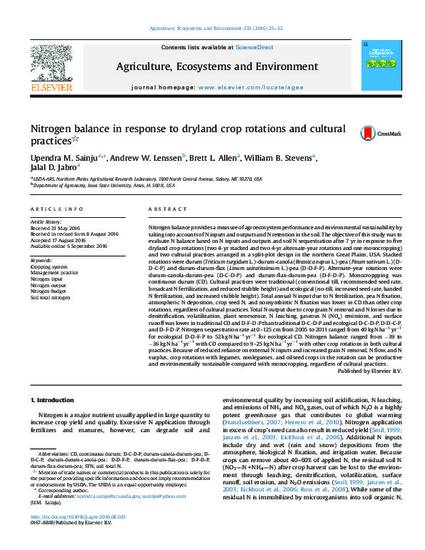
Article
Nitrogen balance in response to dryland crop rotations and cultural practices
Agriculture, Ecosystems & Environment
Document Type
Article
Disciplines
Publication Version
Published Version
Publication Date
10-3-2016
DOI
10.1016/j.agee.2016.08.023
Abstract
Nitrogen balance provides a measure of agroecosystem performance and environmental sustainability by taking into accounts of N inputs and outputs and N retention in the soil. The objective of this study was to evaluate N balance based on N inputs and outputs and soil N sequestration after 7 yr in response to five dryland crop rotations (two 4-yr stacked and two 4-yr alternate-year rotations and one monocropping) and two cultural practices arranged in a split-plot design in the northern Great Plains, USA. Stacked rotations were durum (Triticum turgidum L.)-durum-canola (Brassica napus L.)-pea (Pisum sativum L.) (D-D-C-P) and durum-durum-flax (Linum usitatissimum L.)-pea (D-D-F-P). Alternate-year rotations were durum-canola-durum-pea (D-C-D-P) and durum-flax-durum-pea (D-F-D-P). Monocroppping was continuous durum (CD). Cultural practices were traditional (conventional till, recommended seed rate, broadcast N fertilization, and reduced stubble height) and ecological (no-till, increased seed rate, banded N fertilization, and increased stubble height). Total annual N input due to N fertilization, pea N fixation, atmospheric N deposition, crop seed N, and nonsymbiotic N fixation was lower in CD than other crop rotations, regardless of cultural practices. Total N output due to crop grain N removal and N losses due to denitrification, volatilization, plant senescence, N leaching, gaseous N (NOx) emissions, and surface runoff was lower in traditional CD and D-F-D-P than traditional D-C-D-P and ecological D-C-D-P, D-D-C-P, and D-F-D-P. Nitrogen sequestration rate at 0–125 cm from 2005 to 2011 ranged from 40 kg N ha−1 yr−1 for ecological D-D-F-P to 52 kg N ha−1 yr−1 for ecological CD. Nitrogen balance ranged from −39 to −36 kg N ha−1 yr−1 with CD compared to 9–25 kg N ha−1 yr−1 with other crop rotations in both cultural practices. Because of reduced reliance on external N inputs and increased grain N removal, N flow, and N surplus, crop rotations with legumes, nonlegumes, and oilseed crops in the rotation can be productive and environmentally sustainable compared with monocropping, regardless of cultural practices.
Rights
Works produced by employees of the U.S. Government as part of their official duties are not copyrighted within the U.S. The content of this document is not copyrighted.
Language
en
File Format
application/pdf
Citation Information
Upendra M. Sainju, Andrew W. Lenssen, Brett L. Allen, William B. Stevens, et al.. "Nitrogen balance in response to dryland crop rotations and cultural practices" Agriculture, Ecosystems & Environment Vol. 233 (2016) p. 25 - 32 Available at: http://works.bepress.com/andrew_lenssen/99/

This article is from Agriculture, Ecosystems & Environment 233 (2016): 25–32, doi:10.1016/j.agee.2016.08.023.